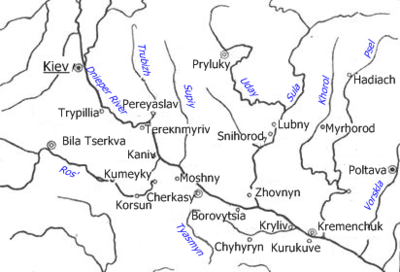Taras Fedorovych

Taras Fedorovych (
Between 1629 and 1636, Fedorovych played a key role in the regional conflicts involving the rebellion of the
With many circumstances of his life remaining mysterious to this day, Fedorovych is a revered figure in both
Early life
Taras Fedorovych was born to a
Fedorovych uprising
Hostilities

In March 1630, Fedorovych became the leader of a Cossack and peasant revolt, which became known as the
The Cossack uprising fell on the fertile ground of the overall condition of Ukrainian peasantry who under Polish control were subject to continued
About ten thousand rebels proceeded from the
Fedorovych addressed the Ukrainian commoners with several
As clashes increased, casualties rose on both sides. After a victory at Korsun over the Polish army sent against them,[5] the rebel Cossacks controlled a large territory that included Korsun, Pereiaslav, Kaniv as well as other cities, with Pereiaslav becoming their main base.
In response to their successes, a large Polish army led by
Negotiations
Fedorovych's military successes forced Koniecpolski to start negotiations with the
Fedorovych, uncertain of the decision that would be reached, over his head, by the "compromising" faction of Cossack leadership, left Pereiaslav along with other Cossacks dissatisfied with the agreement and headed for the Cossack stronghold of the Zaporizhian Sich. Meanwhile, the Cossack leadership faction inclined to a compromise with Poland, elected Timofiy Orendarenko whose Hetmanship was confirmed with Koniecpolski's agreement. Fedorovych, disgruntled with this turn of events, tried to raise the Cossack masses to start a new uprising, but the energy for such an undertaking was no longer forthcoming.
Russia's ally
Fedorovych fought on the Russian side in the Smolensk War against Poland (1632–34). In the winter of 1634-35 he yet again tried to convince the Cossacks to turn against the Poles at the Kaniv Council, but received only very limited support.
In 1635 he negotiated with the Russians the resettlement of 700 Cossacks in Russian-leaning Sloboda territories and, in 1636, suggested the creation of a pro-Russian Cossack regiment. His proposal was rejected by the Russians who did not want to endanger their new relationship with Poland after the recently concluded Treaty of Polyanovka.
Details of his later life are unknown.
Legacy and place in history
Documentation of most of the details of Taras Fedorovych's life has been lost in time, including the year and circumstances of his death. There is no specific record of his activities before the mid- to late-1620s, and after 1636. The brief period, however, in which he played one of the leading roles in the region's history, established his name as an ancient and lasting source of inspiration to future generations of Ukrainians.
Taras Shevchenko wrote a heroic poem, Taras Night, around Triasylo's character.
Fedorovych is one of four Ukrainian hetmans mentioned in the original version (published in 1863) of
/ And Taras Triasylo / Call us from beyond the grave / To the holy battle".In 1926, a feature film, Taras Triasylo, directed by Pyotr Chardynin, was released by the All-Ukrainian Kino Foto Direction (BUFKU).[7] It recounted the then nearly three-hundred-year-old events through the silent-movie prism of the Soviet film industry.
Taras Tryasila Street exists in Kyiv
References
- ^ George Gajecky & Alexander Baran, "Cossacks in the Thirty Year War" Vol.1 Rome 1969, p. 41, Vol.2 p. 73.
- ^ ISBN 966-504-237-8 (t. 3). Article: Taras Fedorovych
- ^ ISBN 5-7702-0554-7
- ^ ISBN 5-86248-015-3.
- ^ ISBN 966-504-237-8 (t. 3). Article: Fedorovych Uprising
- ^ "Poland, history of". In Encyclopædia Britannica Online.
- ^ Тарас Трясило, Энциклопедия отечественного кино, ред. Любовь Аркус
- Ivan Krypyakevych, "Istoriia ukrainskogo viyska", Repr. d. Ausg. L'viv 1936. Kiev, Pamyatky Ukraini. 1992. LCCN 55-34275
